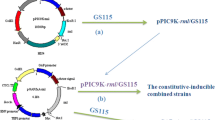Abstract
Propeptides are short sequences that facilitate the folding of their associated proteins. The present study found that the propeptide of Rhizomucor miehei lipase (RML) was not proteolytically removed in Escherichia coli. Moreover, RML was not expressed if the propeptide was removed artificially during the cloning process in E. coli. This behavior in E. coli permitted the application of directed evolution to full-length RML, which included both propeptide and catalytic domain, to explore the role played by the propeptide in governing enzyme activity. The catalytic rate constant, k cat, of the most active mutant RML protein (Q5) was increased from 10.63 ± 0.80 to 71.44 ± 3.20 min−1 after four rounds of screening. Sequence analysis of the mutant displayed three mutations in the propeptide (L57V, S65A, and V67A) and two mutations in the functional region (I111T and S168P). This result showed that improved activity was obtained with essential involvement by mutations in the propeptide, meaning that the majority of mutants with enhanced activity had simultaneous mutations in propeptide and catalytic domains. This observation leads to the hypothesis that directed evolution has simultaneous and synergistic effects on both functional and propeptide domains that arise from the role played by the propeptide in the folding and maturation of the enzyme. We suggest that directed evolution of full-length proteins including their propeptides is a strategy with general validity for extending the range of conformations available to proteins, leading to the enhancement of the catalytic rates of the enzymes.



Similar content being viewed by others
References
Anderson DE, Peters RJ, Wilk B, Agard DA (1999) Alpha-lytic protease precursor: characterization of a structured folding intermediate. Biochemistry-Us 38:4728–4735
Baker D, Sohl JL, Agard DA (1992) A protein-folding reaction under kinetic control. Nature 356:263–265
Beer H-D, Wohlfahrt G, Schmid RD, McCarthy JE (1996) The folding and activity of the extracellular lipase of Rhizopus oryzae are modulated by a prosequence. Biochem J 319:351–359
Boel E, Hugejensen B, Christensen M, Thim L, Fiil NP (1988) Rhizomucor miehei triglyceride lipase is synthesized as a precursor lipids 23:701–706
Chen YJ, Inouye M (2008) The intramolecular chaperone-mediated protein folding. Curr Opin Struc Biol 18:765–770. doi:10.1016/j.sbi.2008.10.005
Eder J, Rheinnecker M, Fersht AR (1993) Folding of subtilisin BPN′—characterization of a folding intermediate. Biochemistry-Us 32:18–26
Ikemura H, Takagi H, Inouye M (1987) Requirement of pro-sequence for the production of active Subtilisin-E in Escherichia coli. J Biol Chem 262:7859–7864
Inouye M (1991) Intramolecular chaperone—the role of the pro-peptide in protein folding. Enzyme 45:314–321
Lee YC, Miyata Y, Terada I, Ohta T, Matsuzawa H (1991) Involvement of NH2-terminal pro-sequence in the production of active aqualysin-I (a thermophilic serine protease) in Escherichia coli. Agr Biol Chem Tokyo 55:3027–3032
Raphael A, Aponte SZ, Reinstein J (2010) Directed evolution of Dnak chaperone: mutations in the lid domain result in enhanced chaperone activity. J Mol Biol 399:154–167
Rodrigues RC, Fernandez-Lafuente R (2010) Lipase from Rhizomucor miehei as a biocatalyst in fats and oils modification. J Mol Catal B-Enzym 66:15–32. doi:10.1016/j.molcatb.2010.03.008
Shinde U, Inouye M (1993) Intramolecular chaperones and protein-folding. Trends Biochem Sci 18:442–446
Shinde U, Inouye M (1995) Folding mediated by an intramolecular chaperone—autoprocessing pathway of the precursor resolved via a substrate assisted catalysis mechanism. J Mol Biol 247:390–395
Shinde U, Inouye M (2000) Intramolecular chaperones: polypeptide extensions that modulate protein folding. Semin Cell Dev Biol 11:35–44
Shinde UP, Liu JJ, Inouye M (1997) Protein memory through altered folding mediated by intramolecular chaperones. Nature 389:520–522
Shinde U, Fu X, Inouye M (1999) A pathway for conformational diversity in proteins mediated by intramolecular chaperones. J Biol Chem 274:15615–15621
Silen JL, Frank D, Fujishige A, Bone R, Agard DA (1989) Analysis of prepro-alpha-lytic protease expression in Escherichia coli reveals that the pro region is required for activity. J Bacteriol 171:1320–1325
Turner NJ (2009) Directed evolution drives the next generation of biocatalysts. Nat Chem Biol 5:568–574. doi:10.1038/nchembio.203
Vandenhazel HB, Kiellandbrandt MC, Winther JR (1993) The propeptide is required for in-vivo formation of stable active yeast proteinase-a and can function even when not covalently-linked to the mature region. J Biol Chem 268:18002–18007
Winther JR, Sorensen P (1991) Propeptide of carboxypeptidase-Y provides a chaperone-like function as well as inhibition of the enzymatic-activity. P Natl Acad Sci USA 88:9330–9334
Zhu XL, Ohta Y, Jordan F, Inouye M (1989) Pro-sequence of subtilisin can guide the refolding of denatured subtilisin in an intermolecular process. Nature 339:483–484
Acknowledgments
This work was financially supported by the National High-tech R&D Program (2010AA101502), the Natural Science Foundation of China (21176215 and 21176102) and the Outstanding Young Scholar of Zhejiang Province (R4110092).
Author information
Authors and Affiliations
Corresponding author
Electronic supplementary material
Below is the link to the electronic supplementary material.
ESM 1
(PDF 237 kb)
Rights and permissions
About this article
Cite this article
Wang, J., Wang, D., Wang, B. et al. Enhanced activity of Rhizomucor miehei lipase by directed evolution with simultaneous evolution of the propeptide. Appl Microbiol Biotechnol 96, 443–450 (2012). https://doi.org/10.1007/s00253-012-4049-5
Received:
Revised:
Accepted:
Published:
Issue Date:
DOI: https://doi.org/10.1007/s00253-012-4049-5




